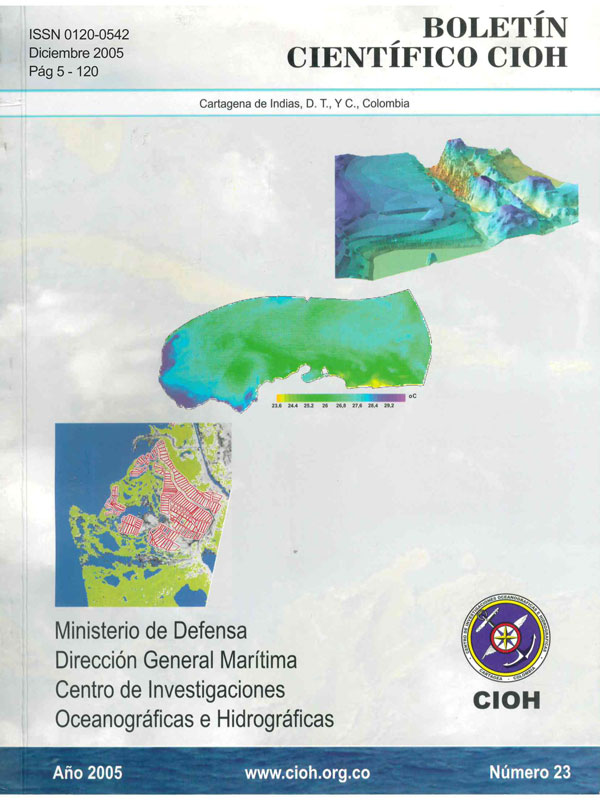Aplicación de la modelación numérica durante la emergencia de derrame por hidrocarburos (Estudio de caso derrame B/T SAETTA)
DOI:
https://doi.org/10.26640/22159045.135Keywords:
Operational Oceanography, Numerical Modeling, Oil Spill, CaribbeanAbstract
A 2.5D oil spill numerical model developed by the CIOH is used in the domain of the colombian coastal water on the Caribbean as: Morrosquillo Gulf, Cartagena Bay and Santa MartaBay. A 3D oceanic numerical model using data assimilation with an oil spill numerical block was implemented for oil spill forecast trajectory as well to know the physical and chemical changes in the Caribbean sea. As a support for marine operations, a wave model is used for sea state forecast.The numerical tools before mentioned had been recently used during oil spills emergencies inSanta Marta Bay (B/T Alma Ata) and Cartagena Bay (B/T Saetta). The results were checked during field inspection.This paper presents the results using numerical modeling during the B/T Saetta oil spill occurred in open waters close to Cartagena.Downloads
References
Anduckia, J. C., S. Lonin y S. Ivanov (2003). Asimilación de datos (TSM) en el modelo pronóstico de las condiciones oceanográficas del Mar Caribe, Boletín Científico CIOH, (21), pp. 38-50.
Anduckia, J. C., S. Lonin, R. J. Molares y C. A. Parra (2003). Validación de imágenes satelitales de temperatura superficial del mar mediante observaciones in situ., Boletín Científico CIOH, (21), pp. 28-37.
Anduckia, J. C. y S. Lonin (2004). Efecto residual de la nubosidad en la asimilación de la temperatura superficial del mar. Boletín Científico CIOH, (22), pp. 36-44.
Centro de Investigaciones Oceanográficas e Hidrográficas (2004). Grupo de Investigación en Oceanografía Operacional, Reporte final proyecto ASHIDRO, Cartagena.
Kasakov, A. L., A. A. Lezhenin y L. S. Speransky (1996). Resultados preliminares del estudio de la capa límite meso meteorológica de la atmósfera en la costanorte colombiana aplicando un modelo numérico, Boletín Científico CIOH, (17), pp.17-26.
Lonin, S. (1997). Hydrodinamic modelling and the problem of oil spills on the colombian Caribbean shoreline, Spill Techonology Newsletter, 22, (1-4), pp. 1-6.
Lonin, S. (1999). Lagrangian model for oil spill diffusion at sea. Spill Science & Technology Bulletin, 5, (N. 5/5-6), pp. 331-336.
Lonin, S. (2001). Modelación numérica de derrame de crudo y un concepto del problema inverso, Boletín Científico CIOH, (19), pp. 15-22.
Lonin, S., J. C. Anduckia, C. A. Parra y R. J. Molares (2003). Sistema de Pronóstico de las Condiciones Oceanográficas del Mar Caribe, Boletín Científico CIOH, (21), pp. 8-27.
Lonin, S., J. C. Anduckia, C. A. Parra y R. J. Molares (2003). Modelo de circulación oceánico con asimilación de datos para el Caribe, aplicado en derrame de hidrocarburos, pesquería y búsqueda y rescate, Contribuciones en ciencias del mar en Colombia, Universidad Nacional de Colombia, pp. 103-119.
Lonin, S. y L. A. López (2003). Pronósticos del viento a partir de los modelos MM5 y UKMO en el Caribe. Boletín Científico CIOH, (21), pp. 51-65.
Lonin, S., C. A. Parra, C. A. Andrade, Y. F. Thomas (2004). Patrones de la pluma turbia del Canal del Dique en la Bahía de Cartagena, Boletín Científico CIOH, (22), pp. 77-89.
Mellor, G. y T. Yamada (1974). A hierarchy of turbulence closure models for planetary boundary layers. J. Atmos. Sci., (31), pp. 1791-1806.
Published
Issue
Section
License
Attribution — You must give appropriate credit, provide a link to the license, and indicate if changes were made. You may do so in any reasonable manner, but not in any way that suggests the licensor endorses you or your use.
NonCommercial — You may not use the material for commercial purposes.
NoDerivatives — If you remix, transform, or build upon the material, you may not distribute the modified material.
No additional restrictions — You may not apply legal terms or technological measures that legally restrict others from doing anything the license permits.



